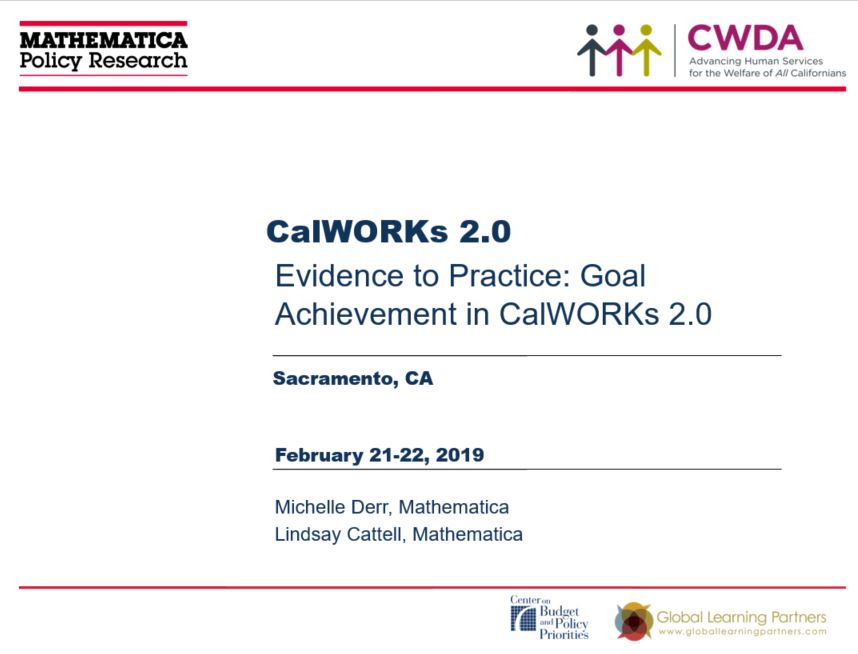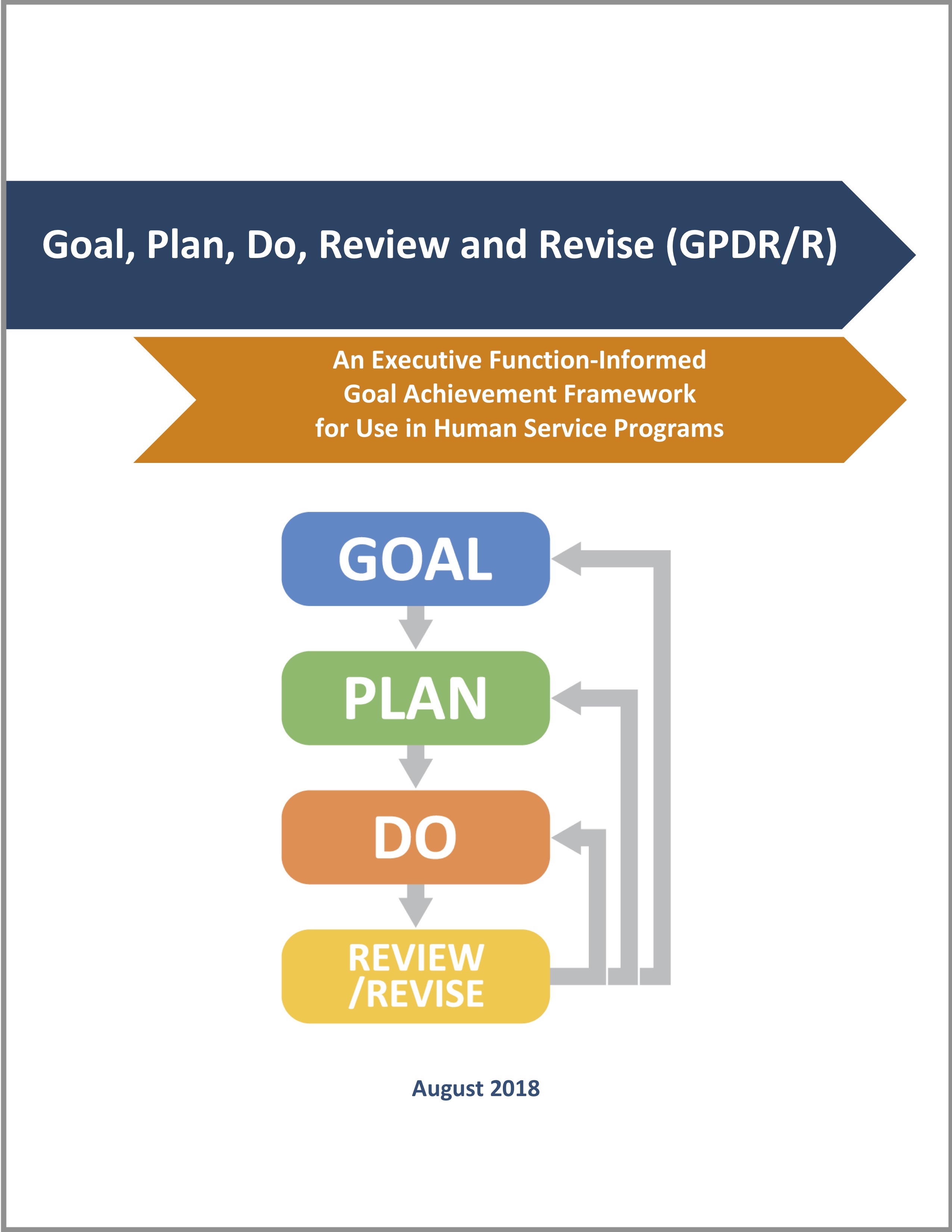TRAINING RESOURCES
Evidence to Practice Training Materials
The purpose of this learning series is for CalWORKs employment services and related staff to explore the evidence base that underlies CalWORKs 2.0 and see how it applies to their everyday work. The workshops do not focus on the tools, but on helping staff internalize and apply the evidence that inspired and guided CalWORKs 2.0.
This package includes five modules with a suggested sequence. We envision that you lead each of the five modules at separate times, so that staff have time to prepare for and focus on each one in turn. Each module is estimated to take two hours. Modules 1 through 3 and modules 4 and 5 are natural pairs if you want to offer them together in a half day.
Modules
- Building adult capabilities
- Addressing scarcity
- Coaching in client interactions
- The art and science of goal achievement
- Coaching with the CalWORKs 2.0 tools
Preparation and follow-up for the participants is key to the success of these modules. Why? Because learning that happens in a workshop often stays in a workshop. We want to create a bridge from and to staff’s day-to-day work. Each module offers a preparatory activity that creates a scaffold of learning upon which the content of the workshop will hang. Each module also offers some ideas for follow-up activities so that staff can recall the content of the workshop in their day-to-day work, and begin to use it where it can really make a difference.
You know your county’s unique context, program, and staff. In keeping with research on adult learning, we strongly encourage you to adapt the content of the modules based on (1) what your staff already know and do well and (2) your program’s greatest interests and opportunities for improvement.
Goal Plan Do Review/Revise (GPDR/R) Video
This video is of Mathematica’s Michelle Derr using the CalWORKs 2.0 Goal Plan Do Review/Revise (GPDR/R) with a client. The video is designed to introduce the process of GPDR/R to county staff and others interested in the process. This video can be used as a part of a staff training event, either individually or in a small-group setting, with interaction with a facilitator before and after viewing. Additional directions for use can be found in the Frontline Staff Guide.
CalMAP Instructional Video
This video helps train staff on the principles and techniques for effective use of the CalMAP worksheet. A demonstration shows a staff member and customer using the CalMAP worksheet for the first time.
This video is best used as part of a staff training event, either individually or in a small-group setting, with interaction with a facilitator before and after viewing. Additional directions for use can be found in the Frontline Staff Guide.
Evidence Behind the Science Underlying CalWORKs 2.0 (April 2018)
This one-day training for CalWORKs employment services and related staff to explore the evidence base that underlies CalWORKs 2.0 and see how it applies it to their everyday work. We will look at what is known about adult capabilities, adult learning, behavioral science, and goal achievement and its implications for how we help our participants set and achieve their goals. These are the materials for the first training conducted in April, 2018
Santa Barbara Training Materials:
+
Other Resources:
- An Approach that Invites Connections – by Jeanette Romkema (JPG)
- Backward Mapping Template – Editable (PowerPoint)
- Helpful Apps to Keep You on Track (PDF)
- My Action Plan – Editable (Word)
- Scarcity Activity Scenarios (PDF)
- Additional Resources (Word)
GPDR/R Guide: An Executive-Function Informed Goal Achievement Framework for use in Human Services Programs
Center for Budget and Policy Priorities and Global Learning Partners, CalWORKs 2.0 development and implementation support partners, have created a new in-depth guide on the Goal, Plan Do, Review and Revise goal achievement framework. The strategies presented in the guide are adaptable to all human service programs, with a special emphasis on job search programs. While the guide has been influenced by many programs nationally, we believe it aligns especially well with the core principles and approaches of CalWORKs 2.0.
The terms “executive function” and “self-regulation” describe the foundation skills that help us to focus, make decisions, and control impulses – as well as to create, execute and adjust plans. Research has shown that we can increase our chances of successfully achieving our goals by reducing competing demands on our weaker skills and by tapping our stronger skills. One proven strategy for doing this is by establishing routines that we use over and over again. Through repeated practice, routines require less and less effort – and they build skills in the process.
A new guide introduces human service staff to practices that lead to successful goal achievement, regardless of an individual’s unique skill strengths or weaknesses. The guide is built around one comprehensive adaptable multi-step framework called Goal, Plan, Do, Review and Revise (GPDR/R). Each step builds on the last and leads to the next; the final step feeds back into earlier steps in an ongoing process of successfully setting and achieving goals.
The GPDR/R framework works best when used in its entirety, again and again—set a goal, craft a detailed plan, put the plan into action, review progress and revise. This process is deceptively simple, but the purpose and intentionality of each step—and the relationship among the steps—is profound.
The strategies presented in the guide can be used in individual meetings or group settings. The guide includes insights and ideas from Global Learning Partners on how to creatively teach GPDR/R. Here are a few additional ideas to get started.
- Send chapters 1 and 2 to your colleagues, and invite them to a conversation: How s this look at goal achievement through the lens of executive skills useful for you, personally? How might it support our work with participants?
- Distribute chapters 3 -5 to staff who work directly with participants. Invite those staff to a workshop in which you practice the steps of GPDR/R among each other and reflect on the experience.
- Invite a small group of colleagues to be part of a road test in which they use the Chapter 5 tools with a few participants and track the effect overtime.
- Invite your staff facilitators to participate in a workshop using the materials in Chapter 6. Then, see what happens as they, in turn, use these designs to lead workshops with participants. Ask participants how they feel about the GPDR/R process and how it is affecting them in their life goals.
In brief, we hope you will use this opportunity to extract whatever chapters of the guide that appeal to you and your colleagues. Read, experiment, test, track and innovate!
GPDR/R Instructional Video
This two-part video invites staff to explore tips and techniques for effective use of the Goal Plan Do Review/Revise (GPDR/R) worksheet.
Part One (10 min) focuses on the first phase of the process: setting a goal (Goal), creating a plan (Plan), and starting to put that plan in action (Do).
Part Two (8 min) focuses on the important phase of the process through which clients review their progress/ challenge (Review) and set a new goal or direction for themselves (Revise).
Each video shows a staff member and client (Nancy) using the GPDR/R worksheet as she walks through the goal achievement process. The week after this session, Nancy sent us an email to thank us for teaching her the GPDR/R process. She said it was such a “practical gift” – and that she had used it with her son to help him pursue one of his own goals!
You can watch the videos individually or in a small-group setting. View them below, or directly in YouTube: Part 1 and Part 2.
Additional resources for learning about this tool can be found in the Frontline Staff Guide, the Evidence to Practice training materials – module 3 and 4 and the GPDR/R worksheet.
You may also view the previous version of this training resource: GPDR/R: A How-To Guide. Watch below, or directly in YouTube here.

 FACILITATOR GUIDE:
FACILITATOR GUIDE: 